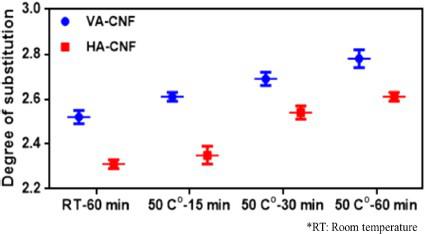Macromolecular Research ( IF 2.4 ) Pub Date : 2020-10-27 , DOI: 10.1007/s13233-020-8146-5 Kyeonga Her , So Hui Jeon , Seunghyeon Lee , Bong Sup Shim

|
Cellulose nanofibers (CNFs) have received considerable attention as reinforcing fillers due to their excellent and versatile properties, including physical, morphological, and chemical features. Despite many advantages of CNFs, the hydrophilic nature of CNFs significantly limits their use as fillers. In this study, CNFs were modified by esterification with two kinds of carboxylic acids: valeric acid (VA) and hexanoic acid (HA). The degree of substitutions (DS) of VA-CNF and HA-CNF was 2.78 ± 0.04 and 2.61 ± 0.02, respectively. The dispersibility in an isopropanol solvent showed the controlled hydrophilicity of the modified CNFs. Moreover, the water contact angles of VA-CNF and HA-CNF were 79.2 ± 3.1° and 85.0 ± 1.7°, respectively, while the neat CNF was just 18.9 ± 1.6°. The thermogravimetric analysis (TGA) revealed that the modified CNFs have much better thermal stability than the neat CNFs. Also, the CNF films showed uniform-sized nano-porous structures after the modifications of CNFs. Combined with well-improved hydrophobicity, these multi-faceted results suggest that our esterification technique of CNFs can be applied in a wide range of eco-friendly materials applications.
中文翻译:

戊酸和己酸酯化纤维素纳米纤维
纤维素纳米纤维(CNF)由于其出色的通用特性(包括物理,形态和化学特性)而作为增强填料受到了广泛的关注。尽管CNF有许多优点,但CNF的亲水性极大地限制了它们作为填料的用途。在这项研究中,CNF是通过用两种羧酸酯化来改性的:戊酸(VA)和己酸(HA)。VA-CNF和HA-CNF的取代度(DS)分别为2.78±0.04和2.61±0.02。在异丙醇溶剂中的分散性显示了改性CNF的受控亲水性。此外,VA-CNF和HA-CNF的水接触角分别为79.2±3.1°和85.0±1.7°,而纯净CNF仅为18.9±1.6°。热重分析(TGA)表明,改性的CNF比纯CNF具有更好的热稳定性。而且,CNF膜在CNF改性后显示出均匀尺寸的纳米多孔结构。与多方面的疏水性相结合,这些多方面的结果表明,我们的CNF酯化技术可广泛应用于生态友好型材料。


























 京公网安备 11010802027423号
京公网安备 11010802027423号